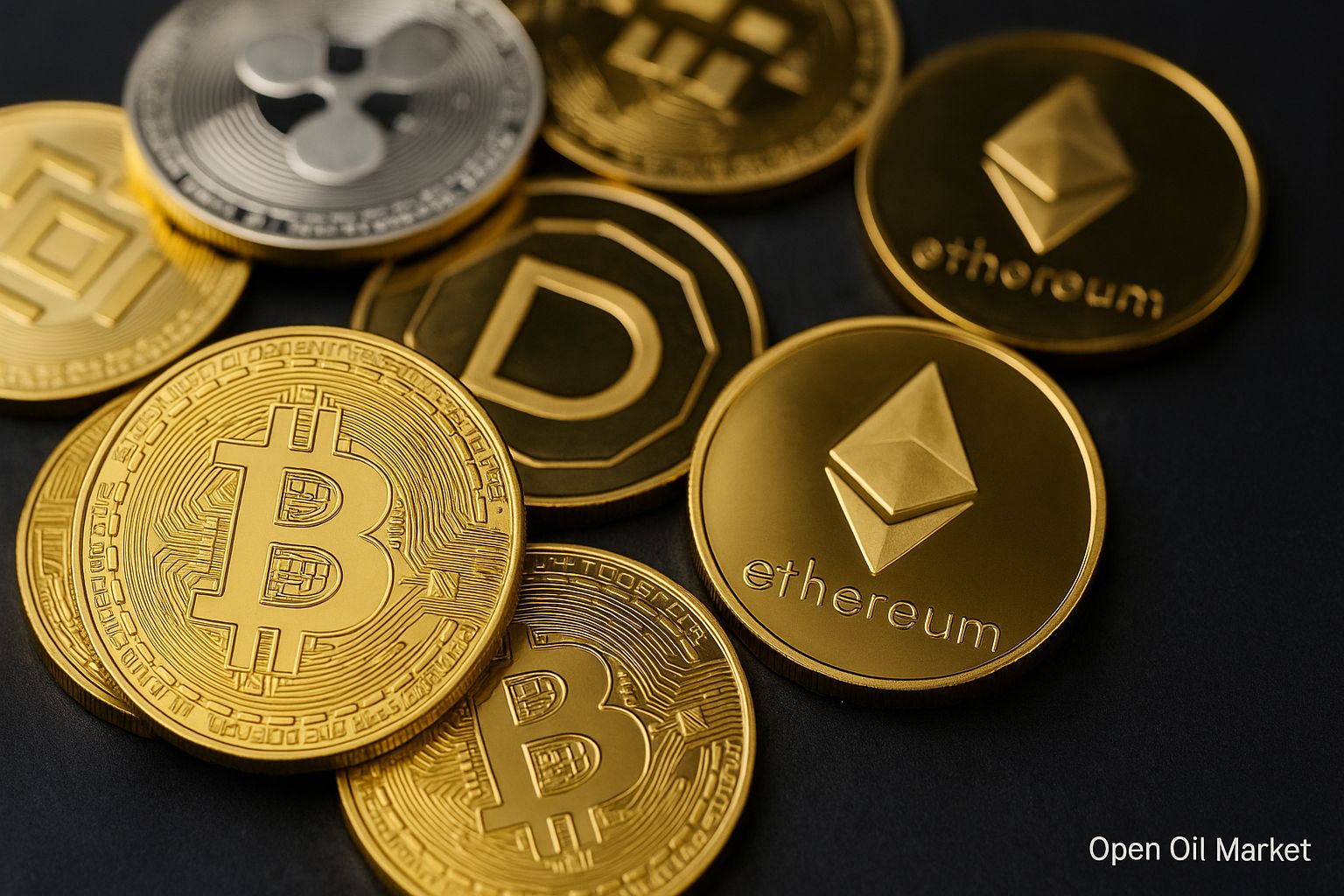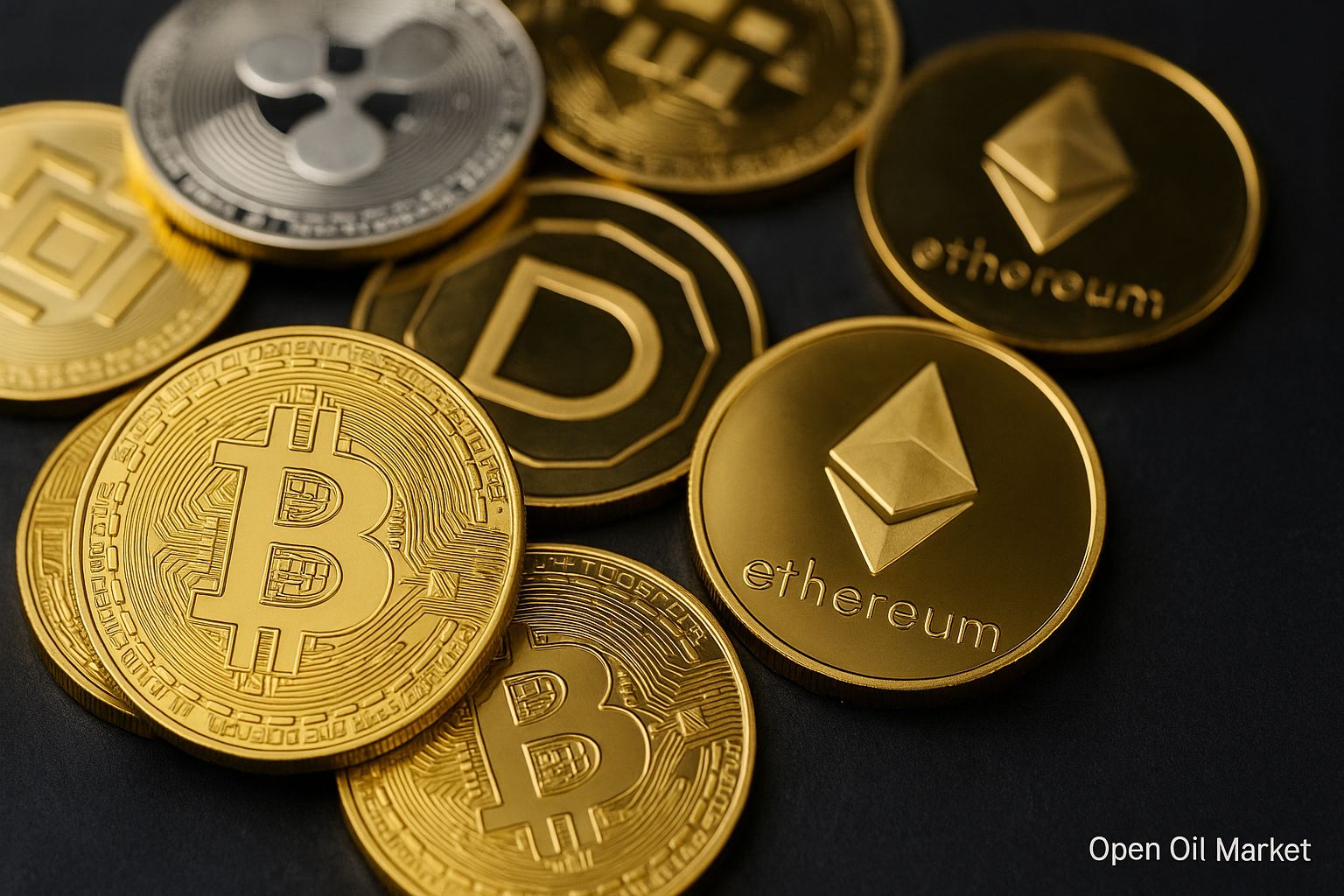
Current Cryptocurrency News for Thursday, August 21, 2025: Bitcoin at Historic Levels, Ethereum Growth, Dynamics of Top 10 Altcoins, and Global Regulatory Initiatives. Analytics for CIS Investors.
The cryptocurrency market is holding onto the positions gained during the recent rally. Bitcoin is consolidating near historical highs, instilling optimism among investors despite a slight correction. Leading altcoins also maintain upward momentum, although market volatility has increased somewhat. Against this backdrop, regulatory events are noteworthy as decisions anticipated in various countries may significantly impact the industry. Below, we will closely examine the current situation, from Bitcoin's movements and key altcoins to institutional interest and measures taken by regulators worldwide.
Bitcoin: Consolidation After Record Growth
Bitcoin (BTC) reached a new historic high last week, exceeding $124,000. Currently, after a correction of about 7–8% from its peak, the leading cryptocurrency is trading around $115,000. This is a natural correction following the rapid growth seen in recent weeks. Some investors have realized profits at high levels, contributing to the price decline; however, the overall sentiment remains positive. Even with this pullback, Bitcoin's price is now nearly double what it was at the beginning of the year, with a market capitalization of approximately $2.2–2.3 trillion (about 58% of the total cryptocurrency market capitalization).
Analysts note that the current slowdown is a healthy "breath of fresh air" before a possible new rally. The crypto market overheated after the swift rise, and a short-term correction has helped relieve excess tension: overbought positions have been liquidated, and traders' leverage has decreased. Technically, key support levels for Bitcoin are around $114,000—holding above these levels signals the maintenance of an upward trend. The resistance zone is positioned around $120,000—confident breakthrough above this mark could pave the way for new all-time highs.
The factors that propelled the BTC rally remain relevant. These include expectations for a softening of monetary policy in the U.S., interest from institutional investors, and positive regulatory news. At the same time, macroeconomic risks persist: unexpected inflation acceleration or tough statements from the Federal Reserve could temporarily cool the market. For now, however, Bitcoin demonstrates resilience: long-term holders are not rushing to sell their coins, viewing BTC as "digital gold." Major companies and funds continue to accumulate assets—well-known corporate investors collectively added several thousand BTC to their balances during the recent decline. This influx of capital from large players supports the market and enhances confidence in the continuation of the bullish trend.
Ethereum at Multi-Month Highs
The second-largest crypto asset, Ethereum (ETH), is also showing upward momentum. At the beginning of this week, Ether exceeded $4,600—its highest level since 2022, coming close to its all-time high ($4,867). After a slight pullback, Ethereum is trading around $4,200, remaining approximately 30% stronger than a month ago. ETH's market capitalization exceeds $500 billion (around 13% of the market), reinforcing its status as the leading altcoin.
Ethereum's growth is largely attributed to institutional demand and fundamental drivers. In the first weeks of August, investors poured record amounts into Ethereum-related products—as inflows to ETH-focused exchange-traded funds (ETFs) significantly outpaced those of Bitcoin funds. For instance, on August 15 alone, American Ether ETFs attracted over $700 million, while Bitcoin ETFs saw about $80 million in inflows during the same period. This leading influx of capital indicates a high level of confidence among major players in Ethereum's prospects.
Reasons behind the optimism surrounding Ether include the anticipation of the launch of the first spot ETF on Ethereum in the U.S. If regulators approve this initiative, access to ETH would broaden for a wider range of investors, potentially triggering a new price growth cycle. Furthermore, the Ethereum ecosystem continues to develop: the network actively implements upgrades and scaling solutions, remaining a key platform for the majority of DeFi protocols, NFT marketplaces, and asset tokenization. With a combination of growing utility and limited supply (after transitioning to PoS, ETH issuance has become deflationary), Ethereum maintains high levels and attracts long-term investors.
Altcoin Market: Growth and Leaders
A wide range of other cryptocurrencies from the top 10 is also showing positive dynamics. Following Bitcoin's rise, investor interest has shifted to many altcoins, several of which have demonstrated noticeable growth (although volatility in this segment has increased). In particular:
- XRP (Ripple) – surged to ~$3.1, marking a multi-year high. The asset gained support from a favorable legal agenda (Ripple's legal victory in its dispute with the SEC) and expectations for an XRP-based ETF launch.
- Binance Coin (BNB) – reached a new record of around $850. The token of the Binance exchange strengthened amidst a surge in trading volumes on the platform and expansion of the BNB Chain ecosystem.
- Solana (SOL) – trades in the $170–180 range. SOL remains one of the growth leaders due to high transaction speeds and the development of DeFi/NFT projects within its network.
- Cardano (ADA) – holds around $0.75. While ADA hasn't shown a sharp jump, the Cardano network is actively advancing in 2025—new smart contracts and decentralized applications are being implemented, sustaining community and investor interest.
- Dogecoin (DOGE) – around $0.22. The popular "meme coin" remains in the top 10 by market capitalization; its price increased due to community engagement and celebrity mentions but is characterized by heightened volatility.
- TRON (TRX) – recently burst into the top ten, trading around $0.33. The TRON network's token has appreciated due to increased transactional activity and the popularity of stablecoins issued within this ecosystem.
Overall, the altcoin segment is developing in mixed directions. Some leading coins (as listed above) are holding their positions after the impressive rally of the first half of the year—the current prices reflect investors' belief in the technical potential of these projects. A number of altcoins are showing moderate corrections from recent local highs (as seen with Cardano and Dogecoin retreating somewhat). Nonetheless, there remains a persistent interest in alternative cryptocurrencies, particularly those backed by active ecosystems or those anticipating an ETF launch. Investors continue to diversify their investments, distributing capital between Bitcoin and promising altcoins.
Record Interest from Institutional Investors
One of the key trends of 2025 is the rapid increase in the share of institutional investments in the crypto market. Major financial organizations—banks, funds, corporations—are actively bolstering their positions in digital assets. This is evidenced by record capital inflows into crypto funds and ETFs throughout the year. Many new custodial services, trading platforms, and analytical tools aimed at professional participants are entering the market, facilitating the entry of traditional finance into the crypto industry. Observers draw parallels between the current phase and the beginning of the 2010s in the gold market when funds and central banks began actively purchasing the precious metal, transforming it from an alternative asset into a mainstream one. Similarly, Bitcoin is increasingly viewed as a strategic reserve and long-term investment by financial institutions.
Recently, following a powerful price rally, signs of short-term profit-taking among large players have emerged. In mid-August, cryptocurrency exchange-traded funds experienced a significant outflow of funds: for example, on August 19, investors withdrew nearly $950 million from American spot Bitcoin and Ethereum ETFs in a single day. This marked the third consecutive trading day of negative flows, reflecting a temporary cooling off after weeks of capital inflow. The overwhelming majority of these sales were for closing "long" positions in BTC and ETH, coupled with a wave of liquidations in the futures market. However, the overall institutional trend remains positive. Major players continue to acquire crypto assets at every dip, and the total volume of institutional investments year-to-date is approaching record levels. This sustained engagement of significant capital creates a solid foundation for the market and strengthens confidence that the bullish cycle is not yet over.
Regulation in the U.S. and Europe: New Rules on the Horizon
Regulatory news is increasingly influencing sentiment in the crypto market. In the U.S., decisions are brewing that could define the rules of the game for years to come. In July, the House of Representatives approved the first comprehensive bill on digital assets—the so-called CLARITY Act (Digital Asset Market Clarity Act of 2025). The document aims to create a clear regulatory framework for the circulation of cryptocurrencies and the operation of exchanges, dividing oversight functions between the Securities and Exchange Commission (SEC) and the Commodity Futures Trading Commission (CFTC). Attention has now shifted to the Senate, where on August 22, the relevant committee is considering its own version of the cryptocurrency regulation bill. It is expected that senators will take into account provisions of the CLARITY Act and seek to develop a compromise approach. The industry has high hopes for these initiatives: the approval of new laws could eliminate legal uncertainties, stimulate capital inflow, and pave the way for new products (such as ETFs for various altcoins). Meanwhile, until the finalization of the documents, caution remains—investors are closely monitoring the debates, understanding that any amendments or delays could impact the market.
Concurrently, U.S. regulators continue to send signals to the market. Recently, the U.S. Department of the Treasury officially stated that it does not plan to include cryptocurrencies in government reserves, limiting itself to the management of previously confiscated digital assets. This news somewhat dampened the boldest expectations regarding direct government involvement in the crypto market. On the other hand, a positive precedent was previously set: the Department of Labor allowed including crypto assets (in a moderate share) in certain 401(k) retirement plans, effectively recognizing cryptocurrencies as a legitimate class of investments for long-term savings. Additionally, the new leadership at the SEC is displaying a more open stance towards the industry: SEC Chair Gary Gensler stated that only a small portion of cryptocurrencies may be considered securities, and the SEC is preparing clear criteria for integrating digital assets into traditional markets. The regulator aims to collaborate with companies wishing to issue tokenized stocks and funds, and has already dropped several high-profile lawsuits against major exchanges initiated under the previous administration. These steps signal a radical shift towards more flexible policies and are a significant victory for an industry long calling for clear regulations.
As for Europe, a unified set of rules is being established. The European Union approved the MiCA regulation (Markets in Crypto-Assets) in 2023, and from 2024 to 2025, its norms are being phased in. MiCA establishes requirements for crypto exchanges, wallets, stablecoin issuers, and other market participants in the EU. By mid-2025, European regulators have already issued licenses under the new rules to several major crypto companies, allowing them to freely offer services across the union. Concurrently, additional measures are being discussed—such as increasing oversight of DeFi protocols and preventing money laundering through digital currencies. Overall, the European approach is quite stringent, but it provides investors with more confidence: transparent rules reduce the risks of sudden bans or sanctions, making the European market attractive for major players who value legal certainty. Furthermore, in several countries (Germany, Switzerland, France), local financial regulators support the adoption of blockchain and allow banks to work with digital assets, which also improves the investment climate.
Global Initiatives: Asia, Latin America, and Other Regions
Regulatory and strategic actions regarding cryptocurrencies are being undertaken not only in the West but across the globe. In Asia, particular attention is drawn to China, which, despite a ban on cryptocurrencies in mainland China, is making interesting moves via Hong Kong. Media reports indicate that Chinese authorities are planning to launch the first stablecoin pegged to the yuan in Hong Kong—a special administrative region with greater financial freedom. Hong Kong regulators have already prepared the legislative framework: as of August 1, 2025, rules on the licensing of stablecoin issuers came into effect. However, the HKMA (Hong Kong Monetary Authority) stated that the first licenses would not be issued until 2026, and the number will be strictly limited. Nonetheless, major Chinese companies are not wasting time: tech giant JD.com and the financial division of Ant Group (affiliated with Alibaba) have already announced intentions to obtain such licenses and issue their own stablecoins. It is expected that the new coins may be pegged to the Hong Kong dollar (rumored to be the "JD Coin" project) or other currencies. Essentially, Beijing is responding to global trends: as the U.S. promotes dollar-pegged stablecoins through private firms, China is laying the groundwork for the digital yuan, which in the long run could reduce dependence on the dollar in regional trade.
In Latin America, a key event has been Brazil's initiative. On August 20, public hearings took place in Brazil's Chamber of Deputies concerning a bill to create a national Bitcoin reserve. The proposal sets out to form a strategic reserve of BTC using part of the country’s gold and foreign exchange reserves (gradually increasing the Bitcoin share to 5% of reserves). If this initiative garners support, Brazil could become one of the first major economies to officially incorporate cryptocurrency into the structure of its sovereign reserves—such a move seemed unthinkable just a few years ago. Experts note that such a decision would increase Bitcoin's legitimacy and could encourage other nations to consider cryptocurrencies as a reserve asset (the example of small El Salvador, which made BTC legal tender, is gradually inspiring larger countries).
Similar ideas are being discussed in the Southeast Asia region. Authorities in Indonesia have stated they are exploring the possibility of forming their own Bitcoin reserve and developing mining based on renewable energy sources. For this resource-rich country, this could be a double advantage: diversifying national reserves and attracting investments in "green" mining. Meanwhile, Thailand is progressing towards integrating cryptocurrencies into tourism: starting August 21, the pilot program TouristDigiPay will be launched, allowing foreign tourists to freely exchange cryptocurrency for Thai baht under strict regulatory control. This initiative aims to connect the crypto-economy with the tourism sector while maintaining financial oversight.
In the Middle East and other regions, the competition for status as a crypto hub continues: jurisdictions such as the UAE and Singapore are refining their regulations in a bid to attract blockchain companies. The global trend is evident: governments are integrating cryptocurrencies into existing financial systems through clear rules. In the long term, this reduces legal risks for investors and large market players and indicates that the crypto industry has firmly established itself within the global financial system.
Russia and the CIS: A Focus on Control and the Digital Ruble
In Russia, regulators continue to tighten control over cryptocurrencies while simultaneously promoting their own state initiatives. Banks are allowed to offer qualified investors instruments linked to cryptocurrency prices (derivatives and tokenized securities). There is a discussion about creating a limited exchange platform for a narrow circle of professionals. However, conditions are becoming stricter for ordinary users: new amendments permit banks to block accounts during P2P transactions with crypto assets, and changes to the "Payment System Law" expand the criteria for "high-risk" transactions and the responsibility for money laundering through digital assets.
At the same time, the state has set its sights on issuing a digital ruble (full launch is expected by 2026). Some projects involving the issuance of ruble-pegged stablecoins are already being utilized for international transactions and circumventing sanctions. For example, the A7A5 token is being used in transactions: just in July, the volume of operations via such unofficial "digital rubles" exceeded $40 billion. These examples illustrate how Russian participants are utilizing digital assets in the face of external restrictions, despite increased internal oversight.
Other countries in the region are also experimenting with cryptocurrencies. Kazakhstan, for instance, launched the first Bitcoin ETF in Central Asia in mid-August (on the AIX platform in Astana), reflecting the region's interest in integrating crypto assets into the traditional market under regulation. Overall, the governments of CIS countries are balancing between the opportunities presented by blockchain and risks to financial stability. Strengthening oversight is a common trend (as evidenced by the case of Russia), but authorities also recognize the necessity for innovation—whether it's launching national digital currencies or participating in international blockchain projects—to keep pace with the global crypto economy.
Market Sentiment and Forecasts
Following a tumultuous start to August, sentiment in the cryptocurrency market remains confidently optimistic, although some of the euphoria from the past weeks has diminé. The absence of sharp price fluctuations is perceived as a sign of a healthy market: participants are consolidating their profits and awaiting new drivers. Investors expect continued growth but note that the crypto market remains highly volatile. A key factor will be the monetary policies of major central banks. The anticipated decrease in interest rates by the U.S. Federal Reserve and other regulators in 2025–2026 could further increase demand for risk assets, including cryptocurrencies.
Ongoing institutional capital inflows (through ETFs and tokenized products) provide a solid foundation for the sector's growth. At the same time, it is crucial to monitor regulatory actions and innovations in the DeFi and Web3 spaces. Experts believe that projects with real utility, strong fundamentals, and engaged communities will remain in focus for investors. Overall, the positive dynamics of the cryptocurrency market persist against a backdrop of increasingly deep integration with traditional finance. Some analysts even forecast that if current trends continue, Bitcoin could reach significantly higher levels (with the most ambitious targets being $150,000–200,000 in the coming years), although such estimates come with caveats due to market unpredictability.
In the near term, participants' attention will be drawn to macroeconomic events—such as Federal Reserve Chair Jerome Powell's speech at the symposium in Jackson Hole later this week—which may affect risk appetite. However, considering that cryptocurrencies are now firmly in the sights of both retail and institutional investors, this asset class will likely remain a dynamic and significant part of the global financial ecosystem. The cryptocurrency market is set for a busy remainder of 2025: investors have opportunities for further growth, but new challenges cannot be ruled out either.
Top 10 Most Popular Cryptocurrencies: Current Status
- Bitcoin (BTC) – around $115,000. The first cryptocurrency remains the largest in the market (approximately 55–60% of total capitalization) and is holding at its achieved heights. Investors view Bitcoin as "digital gold" and a hedge against inflation risks, sustaining strong demand for BTC.
- Ethereum (ETH) – around $4,200. The largest altcoin (~13% of the market) is strengthening due to network updates and record inflows of institutional investments. The immediate target is to surpass the $4,600 mark and update its all-time high amidst a deflationary issuance model for ETH and widespread use of its blockchain in decentralized applications.
- Tether (USDT) – ~$1, stablecoin #1. USDT provides liquidity to the crypto market, remaining the main tool for "parking" capital between transactions. The issuer Tether is preparing to launch a regulated stablecoin in the U.S., highlighting the high demand for reliable "digital dollars."
- Binance Coin (BNB) – ~$800. The token of the largest cryptocurrency exchange, Binance, recently reached an all-time high amid rising activity on the platform. Despite tightening regulation in various countries, BNB has solidified its status as one of the leading coins, offering holders advantages on the exchange and within the BNB Chain ecosystem.
- USD Coin (USDC) – ~$1, stablecoin #2. The coin issued by the Centre consortium (Circle and Coinbase) plays a key role in digital transactions. Complete reserve coverage and transparency have made USDC the benchmark for regulatory compliance, especially against the backdrop of new laws on stablecoins.
- XRP (Ripple) – ~$3.0. The token of the Ripple payment network surged to new multi-year highs in July, first exceeding the $3 mark since 2018. The recovery of XRP's positions is linked to legal clarity in the U.S. after the lengthy court dispute and expectations for the launch of XRP-based ETFs. The coin attracts institutional investors as an effective tool for cross-border payments.
- Solana (SOL) – ~$175. A promising layer-one blockchain known for its high transaction speed, SOL maintains its place among the leaders. The coin has demonstrated significant growth over the year due to the development of the DeFi and NFT ecosystems in Solana and rumors of a possible ETF launch for SOL. Investors note the improvement in network stability after previous technical disruptions.
- Cardano (ADA) – ~$0.75. The largest PoS blockchain with a scientific approach to development. While ADA has not set new records, it consistently ranks in the top 10. In 2025, the Cardano network is undergoing an active stage of developing smart contracts and decentralized applications, which supports community and investor interest.
- Dogecoin (DOGE) – ~$0.22. The popular meme cryptocurrency, initially created as a joke, remains one of the largest coins by market capitalization. DOGE is correcting after spikes in growth but continues to be in demand due to its loyal community and support from influential figures. Dogecoin's volatility increases at times influenced by social media, but overall the coin follows the movements of the broader altcoin market.
- TRON (TRX) – ~$0.33. A platform for smart contracts and decentralized services founded by Justin Sun, TRX recently burst into the top ten. This week, it showed slight growth, standing out amid stagnation in parts of the altcoin sector. The Tron network attracts users with low fees and is actively used for stablecoin issuance and tokenization, supporting its price trend.




